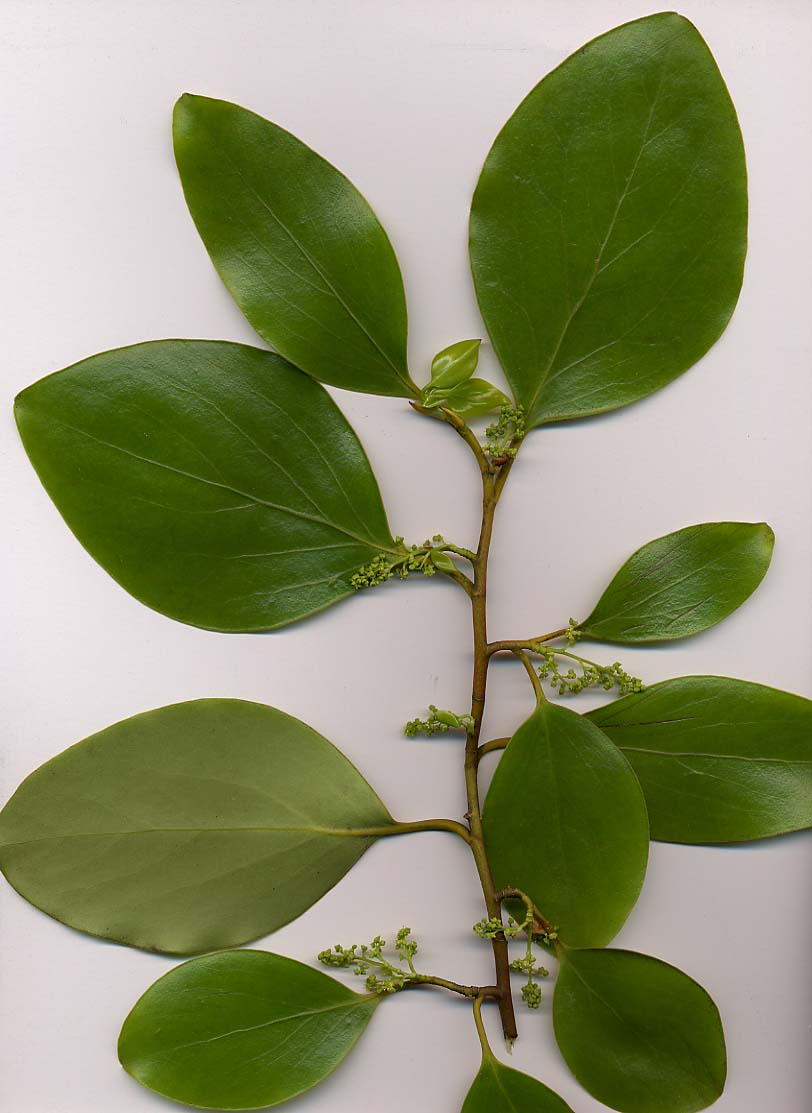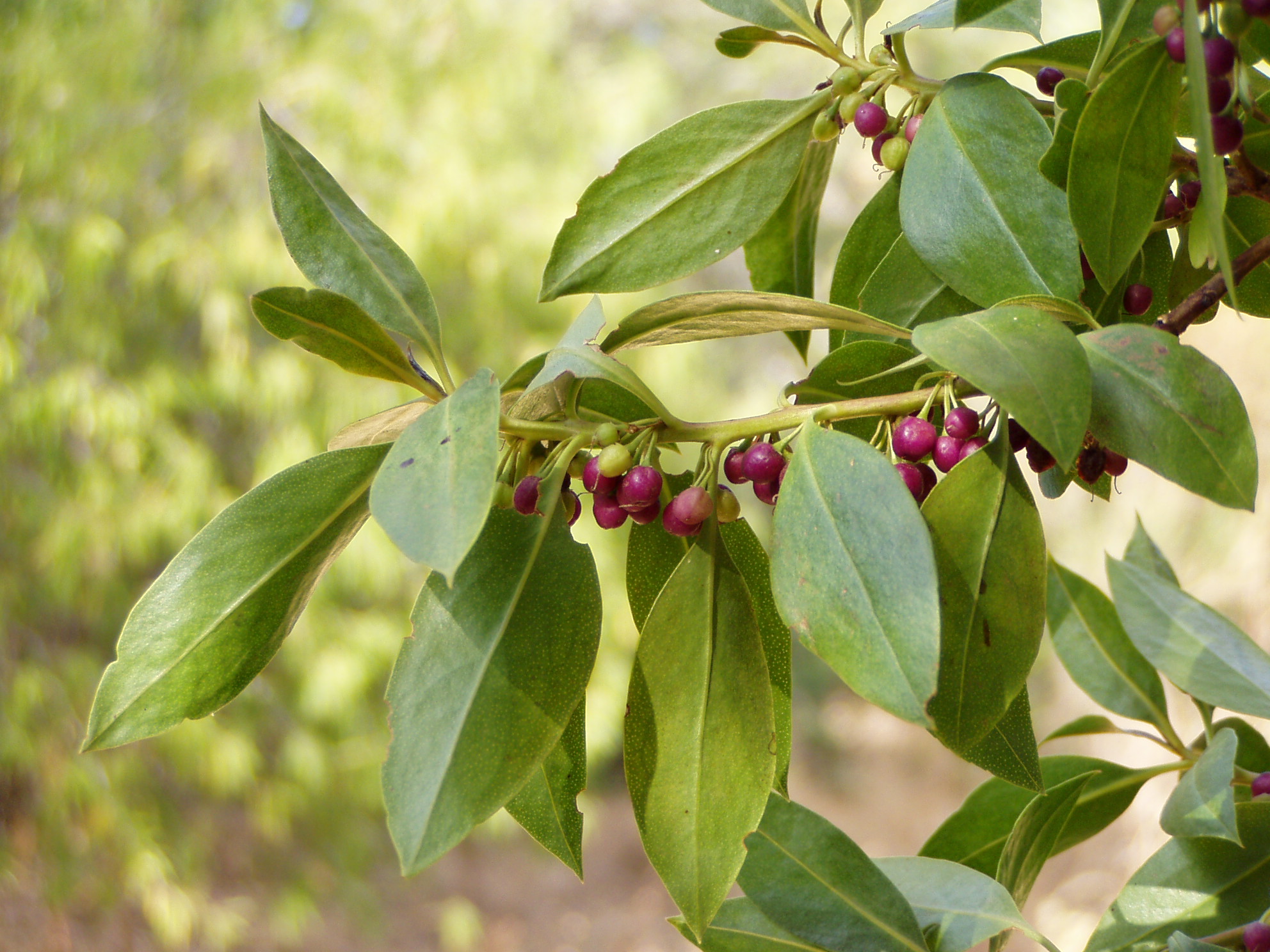Broadleaf (Kapuka, Papauma)
Griselinia littoralis
Griselinia littoralis, commonly known as Broadleaf, Kapuka, or Papauma, is a versatile and hardy native tree of New Zealand. With its glossy, leathery leaves and dense growth habit, this adaptable species thrives in challenging coastal conditions while also performing well in urban environments. Valued for its wind tolerance, attractive foliage, and ability to function as both a specimen tree and a hedge plant, Broadleaf has become an important species for both ecological restoration and ornamental landscaping throughout New Zealand.

Image credit: Wikipedia
Quick Facts
| Height | 1-10 meters (up to 15m in ideal conditions) |
|---|---|
| Spread | 2-5 meters |
| Water Needs | Low to moderate |
| Light | Full sun to partial shade |
| Frost Tolerance | Moderate (-10°C) |
| Salt Tolerance | High |
| Growth Rate | Moderate to fast |
| Lifespan | 50+ years |
Climate Best Suited To
Griselinia littoralis is found throughout New Zealand from sea level up to 900m altitude, ranging from the far north to Stewart Island. It is particularly abundant in coastal areas due to its exceptional tolerance of salt-laden winds and exposed conditions. In the North Island, it tends to grow at higher altitudes than in the South Island, where it is more widespread.
Regional Suitability
| City | Climate Suitability |
|---|---|
| Whangārei | Ideal |
| Auckland | Ideal |
| Hamilton | Ideal |
| Tauranga | Ideal |
| Rotorua | Ideal |
| Gisborne | Ideal |
| New Plymouth | Ideal |
| Napier | Ideal |
| Whanganui | Ideal |
| Palmerston North | Ideal |
| Wellington | Ideal |
| Nelson | Ideal |
| Christchurch | Ideal |
| Dunedin | Ideal |
| Invercargill | Ideal |
Growing Requirements
Soil Requirements
Broadleaf prefers:
- Free-draining soil (light loamy type)
- Tolerates a wide range of soil types
- Performs well in poor soils
- Slightly acidic to neutral pH (6.0-7.0)
- Can handle coastal sandy soils
- Dislikes waterlogged conditions
Light Requirements
This adaptable plant thrives in:
- Full sun to partial shade
- Performs best with at least 4-6 hours of direct sunlight
- Can tolerate shade but growth may be less dense
- Ideal for east or west-facing locations
- Variegated forms may need more light to maintain coloration
Water Requirements
Broadleaf has:
- Low to moderate water needs once established
- Requires regular watering during establishment (first 1-2 years)
- Drought tolerant when mature
- Benefits from occasional deep watering during extended dry periods
- Dislikes constantly wet roots
Temperature Tolerance
This hardy plant can handle:
- Temperatures down to about -10°C (14°F)
- Heat up to 35°C (95°F)
- Coastal temperature fluctuations
- Young plants may need protection from severe frosts
- Excellent wind tolerance, including salt-laden winds
Planting & Care
Planting Tips
- Best planted in spring or autumn
- Dig a hole twice the width of the root ball
- Plant at the same depth as it was in the container
- Water thoroughly after planting
- Apply a layer of mulch around the base (avoiding the trunk)
- Space 1-2m apart for hedging
- For specimen trees, allow 3-5m spacing
Pruning & Maintenance
- Requires minimal maintenance once established
- Can be heavily pruned if needed - responds well to shaping
- Ideal for hedging - trim 2-3 times during growing season
- Remove any damaged or diseased branches as they occur
- Can be kept compact with regular trimming
- Naturally forms a dense, rounded shape if left unpruned
Fertilizing
- Generally doesn't require much fertilizer
- Apply a balanced slow-release fertilizer in spring if desired
- Mulch annually with compost to improve soil
- Avoid high-nitrogen fertilizers which can promote soft growth
- For hedges, a light application of fertilizer after trimming can promote dense growth
Companion Planting
- Pairs well with other coastal natives like Coprosma repens
- Provides shelter for smaller native plants
- Good backdrop for flowering natives like Hebe species
- Combines well with native grasses for textural contrast
- Can be underplanted with shade-tolerant ground covers
Propagation Methods
Seed Propagation
For best results:
- Collect berries when ripe (dark purple to black) in autumn
- Remove pulp and clean seeds
- Sow fresh seeds in a well-draining seed mix
- Cover lightly with fine grit or vermiculite
- Keep moist but not wet
- Germination can take 1-3 months
- Transplant seedlings when large enough to handle
- Grow on in containers for at least a year before planting out
Cutting Propagation
The most reliable method:
- Take semi-hardwood cuttings in late summer to autumn
- Select healthy stems 10-15cm long
- Remove lower leaves, keeping 2-3 leaves at the top
- Dip cut end in rooting hormone (optional but helpful)
- Insert into a mix of perlite and peat or potting mix
- Keep humid but with good air circulation
- Roots should develop within 6-8 weeks
- Pot up rooted cuttings individually
- Grow on for at least 6 months before planting out
Layering
For established plants:
- Select a low, flexible branch in spring
- Make a small nick in the bark where it will touch the ground
- Peg the branch to the soil with a wire or stone
- Cover the contact point with soil
- Keep moist throughout the growing season
- Roots should form by autumn
- Once well rooted, cut from the parent plant
- Transplant to a new location or pot
Cultural History
Griselinia littoralis has a rich history in New Zealand's natural and cultural landscape:
Traditional Māori Knowledge
- Known as Kapuka or Papauma in te reo Māori
- Bark was traditionally used to treat skin infections
- Wood was occasionally used for small implements
- Recognized for its resilience in coastal environments
- Valued as a shelter tree in exposed locations
Ecological Significance
- Important component of coastal forest ecosystems
- Provides food for native birds through its berries
- Offers shelter and nesting sites for wildlife
- Helps stabilize soil in coastal environments
- Tolerates salt spray, making it crucial for coastal vegetation succession
- Can function as an epiphyte in moist climates, with roots extending to the ground
European Settlement Impact
- Recognized early for its ornamental potential
- Widely cultivated both in New Zealand and internationally
- Valued in the UK and other temperate regions for coastal plantings
- Has received the Royal Horticultural Society's Award of Garden Merit
- Variegated forms developed for ornamental horticulture
Contemporary Significance
Today, Broadleaf is valued both for its ecological role and as a versatile landscaping plant. It is extensively used in coastal restoration projects, urban landscaping, and as a hardy hedge or screen plant. Its ability to withstand challenging conditions while maintaining an attractive appearance makes it one of New Zealand's most practical native plants. The species continues to gain popularity internationally in regions with mild oceanic climates, where it is prized for its salt and wind tolerance.
Pests & Diseases
Common Pests
- Scale Insects: Can infest stems and leaves. Control with horticultural oil or insecticidal soap.
- Mealybugs: Sometimes found in dense growth. Treat with insecticidal soap or neem oil.
- Aphids: Occasionally infest new growth. Wash off with water spray or treat with insecticidal soap.
- Thrips: May cause stippling on leaves. Control with insecticidal soap or appropriate insecticide.
Common Diseases
- Root Rot: Caused by overwatering or poor drainage. Ensure well-draining soil and avoid waterlogged conditions.
- Leaf Spot: Various fungi can cause spotting on leaves. Remove affected foliage and improve air circulation.
- Sooty Mold: Black fungal growth on leaves, often following insect infestations. Control insects and wash off mold.
Environmental Issues
- Frost Damage: Young plants and new growth can be damaged by severe frosts. Protect during establishment.
- Waterlogging: Despite drought tolerance, cannot withstand constantly wet soil. Ensure good drainage.
- Nutrient Deficiency: Yellowing leaves may indicate lack of nutrients. Apply appropriate fertilizer.
Broadleaf is generally very resilient to pests and diseases when grown in appropriate conditions. Its natural adaptations to harsh coastal environments make it one of the more trouble-free native plants. Most issues can be prevented by providing good drainage and appropriate light levels.
Bonus Tip
Create a multi-functional privacy screen by planting Griselinia littoralis as a backdrop, then layering with other native species in front. Start with Griselinia spaced at 1m intervals, then add mid-height shrubs like Coprosma repens or Corokia cotoneaster in front, followed by lower-growing Hebe species and native grasses like Carex or Chionochloa flavicans. This creates not only an effective wind and privacy barrier but also a diverse habitat for native birds and insects. The different leaf textures and colors provide year-round interest, while the layered approach creates a more natural-looking boundary than a single-species hedge. For coastal properties, this combination is particularly effective as all these species have good salt tolerance.


